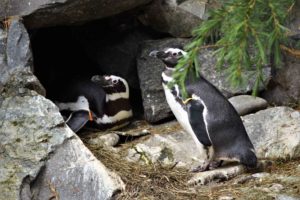CHICK UPDATE: Our penguin chicks have gone behind the scenes to grow bigger and learn to swim. They’ll be back out in a few weeks when they’ve lost their downy feathers, ready to demonstrate their expert swimming skills.
Peck. Peck. Peck. A tiny beak hammers away from the inside of an egg shell, cracks growing slowly at first and then spreading quickly as more progress is made. Faint peeps are heard, then grow louder.
Soon, a fluffy grayish and white chick emerges, its parents carefully observing the progress.
And as two rare Magellanic penguins pip their way out of their shells, a camera carefully set by a keeper catches the whole adorable, fascinating process on video.
The newly hatched chicks are the offspring of mother “Yellow” and father “Orange” (Zoo penguins are named after the color of their ID wing bands) and hatched May 26 and 27, bringing the Penguin Point population to 15. They arrived just in time for World Ocean Weekend, an event celebrating marine life June 1-2 with feeds, keeper chats and enrichments.
This is the third consecutive year for the hatching of penguin chicks through the zoo’s participation in the Association of Zoos’ & Aquariums’ Species Survival Plan® (SSP) managed breeding program for Magellanic penguins, which are near-threatened in the wild. Orange and Yellow were also parents to two chicks last year.

“Yellow and Orange are very attentive parents,” said senior staff biologist Amanda Shaffer, the zoo’s lead penguin keeper. “The parents take turns brooding the chicks, keeping them warm with special patches on their abdomens that allow the chicks contact with their skin.”
On Wednesday, dad Orange calmly sat inside the rock burrow on the two chicks. Mom Yellow stood patiently outside, occasionally lifting her wings as if to stave off possible predators. This level of protectiveness means it could be some time before zoo visitors are able to see the
chicks.
They’ll be hidden much of the time over the next few weeks, keeping warm and safe beneath their parent. They will periodically emerge for feedings, which are accomplished when the parents regurgitate bits of the herring and capelin they’ve already eaten; it’s a protein-filled slurry for the hungry little mouths.
The zoo’s veterinary team plans to give the little birds their first well-penguin checkups on Friday morning.
Magellanic penguins, native to the South American shores of Argentina, Chile, Uruguay and Brazil, are listed as near-threatened on the IUCN Red List, compiled by the International Union for Conservation of Nature.
They are threatened in the wild by a number of factors, including the proliferation of plastics in the ocean, spills of oil and other hazardous materials, and overfishing.
SEE PENGUINS: You can see all the penguins daily at Penguin Point (just uphill from the Wild Wonders Outdoor Theater) but the chicks may not be visible for a while.
CELEBRATE THE OCEAN: At the World Ocean Weekend event, which celebrates all marine life with feeds, keeper chats, enrichments and more.
PROTECT PENGUINS: Find out how to reduce your plastic and eat sustainably.